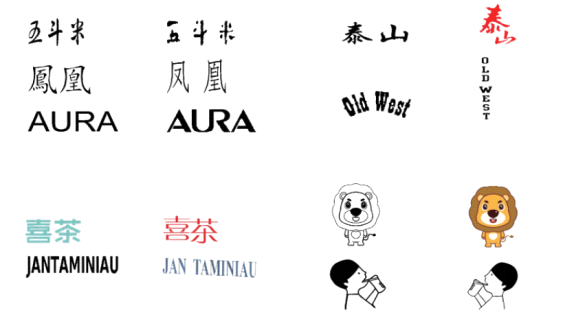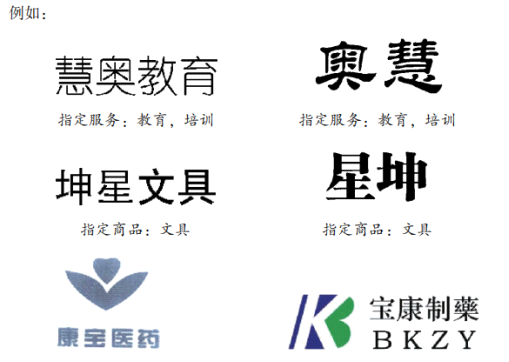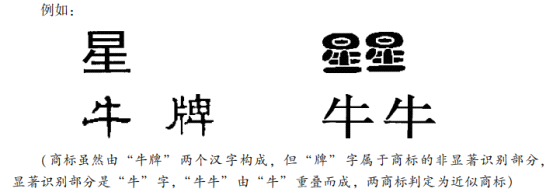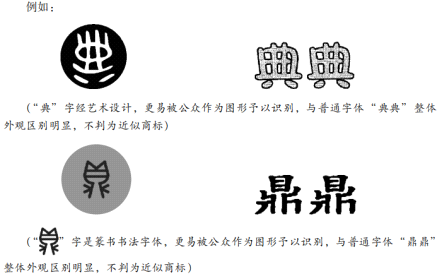The new <Guidelines for Trademark Examination and Trial> (New Guidelines) released by the China National Intellectual Property Administration (CNIPA) on November 16th, 2021 went into effect on January 1st, 2022. It is somewhat analogous to the trademark procedures in the US and Europe. Like the earlier versions, the New Guidelines is divided into two sections, but with a clearer structure. The first section focuses on procedural and formality examination standards. The second section leans more towards the factors for determining the registrability of a trademark, such as the comparison of similarity between an applied trademark and prior trademarks. Compared to the Standards 2016, the Guildelines 2022 have 3 major changes as listed and explained below. Spoiler alert, like all legal contents, it may get a little dry.
1. Registrability, clarifications based on the latest achievements of trademark protection. For instance, it stipulates the examination standards of malicious trademark registration applications without the intention of use. The New Guidelines identify nine typical cases that could be deemed as bad faith applications without intent to use, namely:
A. Filing a large number of trade marks that obviously exceeds the needs of normal business activities and does not have an intent to use;
B. Filing a large number of marks which are copies, imitations of third parties' marks with certain fame or highly distinctive marks;
C. Repeatedly filing one entity's mark which enjoys certain fame or has a strong distinctiveness;
D. Filing a large number of trade marks that are identical with or similar to an other's trade name or its short form, domain name, product's name, packaging or trade dress with certain fame, slogan, design, etc.;
E. Filing a large number of trade marks that are identical with or similar to a celebrity's name, famous work's name or character's name, and other's famous work of arts falling in the public domain;
F. Filing a large number of marks that are identical with or similar to the names of administrative divisions, mountains, scenic spots, building names, etc.;
G. Filing a large number of marks that are identical with or similar to the generic terms, signs directly indicating the quality, main raw materials, function, use, weight and quantity of designated goods or services;
H. Filing a large number of applications for recordal of assignments transferring the registration to many different entities; and
I. An entity which sold many marks to seek improper interests, forced commercial cooperation, and demanded high transfer fees, licensing fees, or infringement compensation from the other entities who used the mark first.
Meanwhile, the Guidelines also specifies that information such as profile of the trademark holder, the overall application situation of the applicant, the commercial behavior of the applicant, the component of the trademarks applied, the evidence submitted by the party of interest and others should all be taken into consideration. This act is to help determine whether the applicant really has the intent to use the applied trademark.
2. Identification, regarding the examination of procedure and formality of similar trademarks. For example, it has included the formality examination criteria for words and device trademarks. The earlier guidelines only included the formality examination standards for 3D, color, and sound trademarks, while relevant standards for words and device trademarks could only be found in the separate Clarification Page of the Regulation on the Implementation of the Trademark Law, etc. Now, you have it all in one scoop.
The following scenarios have been added as lack of distinctiveness, and more examples have been given:
· Words and expressions for daily use
· Only the full name of the applicant (excluding the natural person)
· Internet buzzwords and internet popular emojis
· Commonly used signs and symbols
· Festival name
· Aphoristic sentences
·
Where the mark includes the company's full name, if it also contains a distinctive logo, the mark could still be registerable. Or, if the full name has been used for a long time and has been firmly associated with the entity without confusion, it could be registered.
And, very nicely, the Guidelines 2022 provide plenty of case examples. Below are a few examples, which is mostly legal clauses in regards to similar trademarks. This is where “a picture speaks a thousand words come in”, especially for calligraphy lovers.
Example one: Trademarks with same characters
Trademarks that are the same in language, word composition, character structure, and order, but have only slight variance in font, size, difference in order such as horizontal or vertical, spacing, or color shall be considered as similar trademarks.

Example two: Trademarks with characters of close approximation
Trademarks using Chinese characters that have the same composition with
changes in font, design, phonetic notation, and arrangement, which would likely
lead to confusion of the public regarding the source of the goods or services,
shall be considered as similar trademarks.

If the above examples are not confusing enough, congratulations, here is a few more.
Trademarks with the same Chinese characters, but different arrangement of reduplication, which is likely to lead to confusion of the public regarding the source of the goods or services shall be considered as similar trademarks.

However, if a single Chinese character in the trademark uses artistic designs or ancient calligraphy, which is obviously not likely to be confused as common words, it shall not be considered as a similar trademark.

Determining the similarity of trademarks has always been a tricky task. Although it may not eliminate the identification issue completely, it certainly provides a clearer structure and standard in the similar trademark identification process.
3. Precedents, typical cases that can be used as reference for judgement. China is moving towards bringing changes to the judicial system in the IP market. Since China is a civil law country, which the courts are not obliged to use precedents in their case hearings, there has been an issue of uniformity nationwide.
The latest amendment to the Trademark Law provides a clearer and more direct legal basis for cracking down on bad faith trademark registration. With the joint efforts of the trademark examination department and the law enforcement department, bad faith trademark applications not intended for use and the illegal trademark agency behaviour are effectively curbed.
And the New Guidelines have cited many typical cases in detail which comes very handy in trademark disputes. They include the information of the case and key points considered by the examiners, such as a summary of submitted evidence, the designated goods and/or services of the disputed trademark, etc.
Case 1: Retrial of "jiumuwang" trademark revocation. (Case No. 1400267)
Key points: the evidence submitted by the trademark registrant can prove that the contested trademark sold the clothes hangers, hooks, etc. within the specified period.
"Hardware" products belong to groups of 0609 at the time of litigation for trademark registration, and the products of clothes hangers and hooks actually used by the trademark registrant do not fall into the category of similar goods. However, at the time of the trial, the classification table of similar goods and services had changed, that is, the "hardware" goods can be protected across similar groups of 0607, 0608 and 0609, so the registration of the contested trademark on the "hardware" goods is maintained.
At the litigation stage of the case, the court held that in the absence of evidence to prove that the contested trademark was directly used on the "hardware" goods within the specified period, the registration of the contested trademark on the "metal tool handle; padlock; key" goods could not be maintained on the ground of constituting similar goods.
Case 2: Retrial of "meiqilin" trademark revocation. (Case No. 10048229)
Key points: the evidence submitted by Guangdong Qianfen cosmetics industry Co., Ltd. in the administrative stage is the basis for the State Intellectual Property Office to make specific administrative actions in the revocation case review. It is also the review object of the people's court in relevant administrative proceedings. The act of falsifying evidence seriously neglects the revocation review, administrative procedures, and the fairness of the retrial. Although Guangdong Qianfen cosmetics industry Co., Ltd. withdrew the false evidence submitted, it could not change the fact of its wrong doing. Moreover, the claim was made after the false evidence was clearly pointed out. Therefore, the court found that Guangdong Qianfen cosmetics industry Co., Ltd. forged the above evidence, and the recorded evidence submitted was insufficient to prove that it had made a true, legal and effective commercial use of the contested trademark in the approved goods within the specified period, and the contested trademark was revoked. In addition, the court decided to impose a 10,000 yuan fine on the plaintiff Guangdong Qianfen cosmetics industry Co., Ltd.
Our thoughts
From the above changes, the trade mark protection in China will be enhanced, especially against bad faith applicants, where it will be easier for the right owner to enforce its rights.
And the CNIPA will take a more patriarchal role in trade mark examination, and as a result, there might be more unexpected issues in our new practice.
Reference:
l China’s New Guidelines for Trademark Examination and Trial Elaborate on Malicious Trademark Applications, The National Law Review, November 26th, 2021, https://www.natlawreview.com/article/china-s-new-guidelines-trademark-examination-and-trial-elaborate-malicious-trademark, viewed March 31st, 2022
l Guidelines for Trademark Examination and Trial, 2022 Edition (Chinese only), November 22, 2021, https://www.chinaiplawupdate.com/wp-content/uploads/2021/11/%E5%95%86%E6%A0%87%E5%AE%A1%E6%9F%A5%E5%AE%A1%E7%90%86%E6%8C%87%E5%8D%97.pdf, viewed March 31st, 2022
l Interpretation of the new edition of "Guidelines for Trademark Examination and Trial", January 4th, 2022, https://new.qq.com/omn/20220104/20220104A089AM00.html, viewed March 30th, 2022
l [IP law] Revised Standards for Trademark Examination and Trial, December 7th, 2021, https://www.hfgip.com/news/revised-standards-trademark-examination-and-trial, viewed March 31st, 2022
l Interpretation of the series of guidelines for trademark examination and trial in 2021: comparison between the old and new chapters of the two editions of the judgment on the situation of not using a registered trademark for three consecutive years, February 13th 2022, http://www.360doc.com/content/12/0121/07/8745981_1017206875.shtml, viewed April 1st 2022
Contact: Richard Huang
Tel: +86-133-1370-9579
Email: mail@intenova.cn
Add: 601, No. 54-1 Guanri Rd., Software Park Phase 2, Siming Dist., Xiamen 361008 CHINA